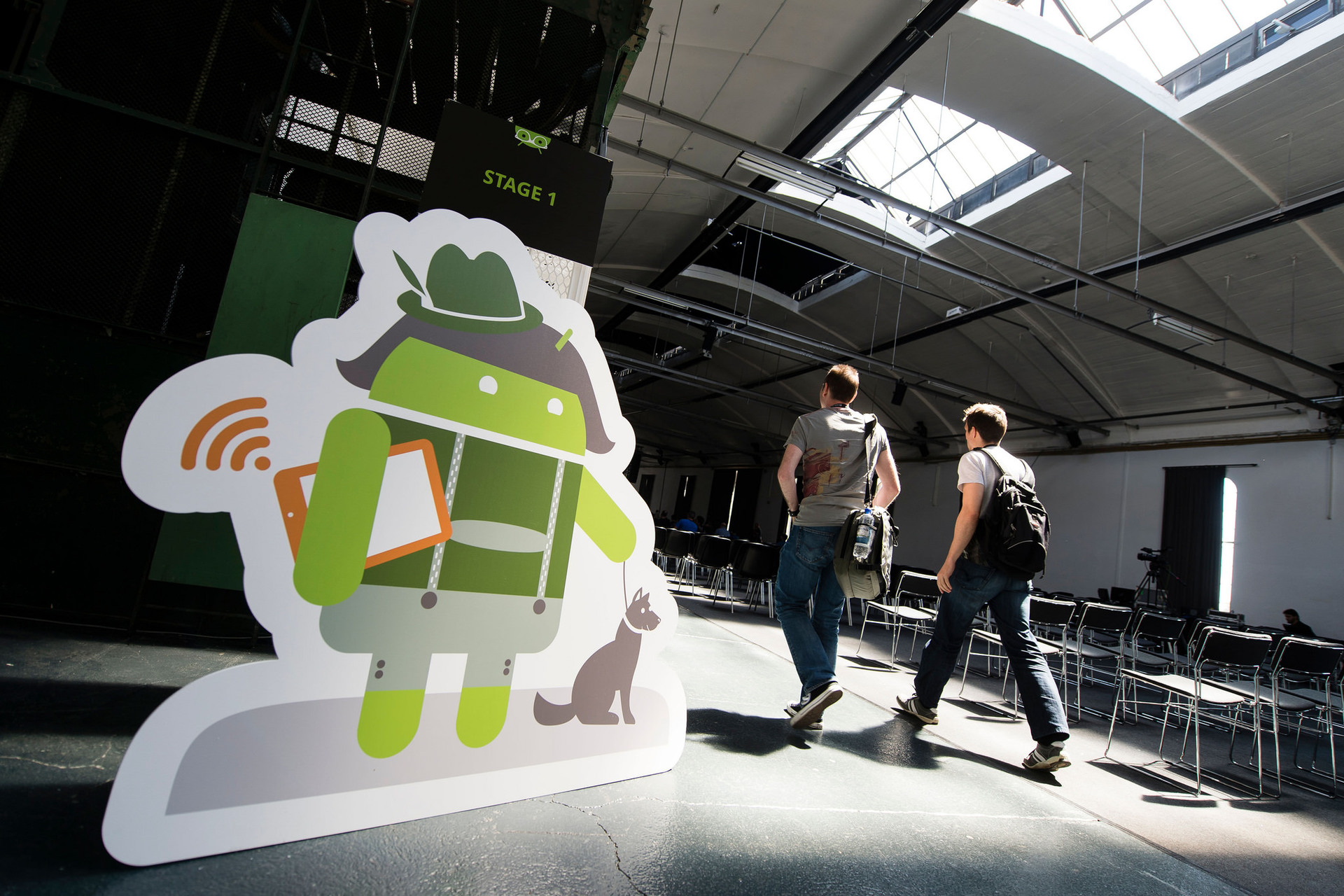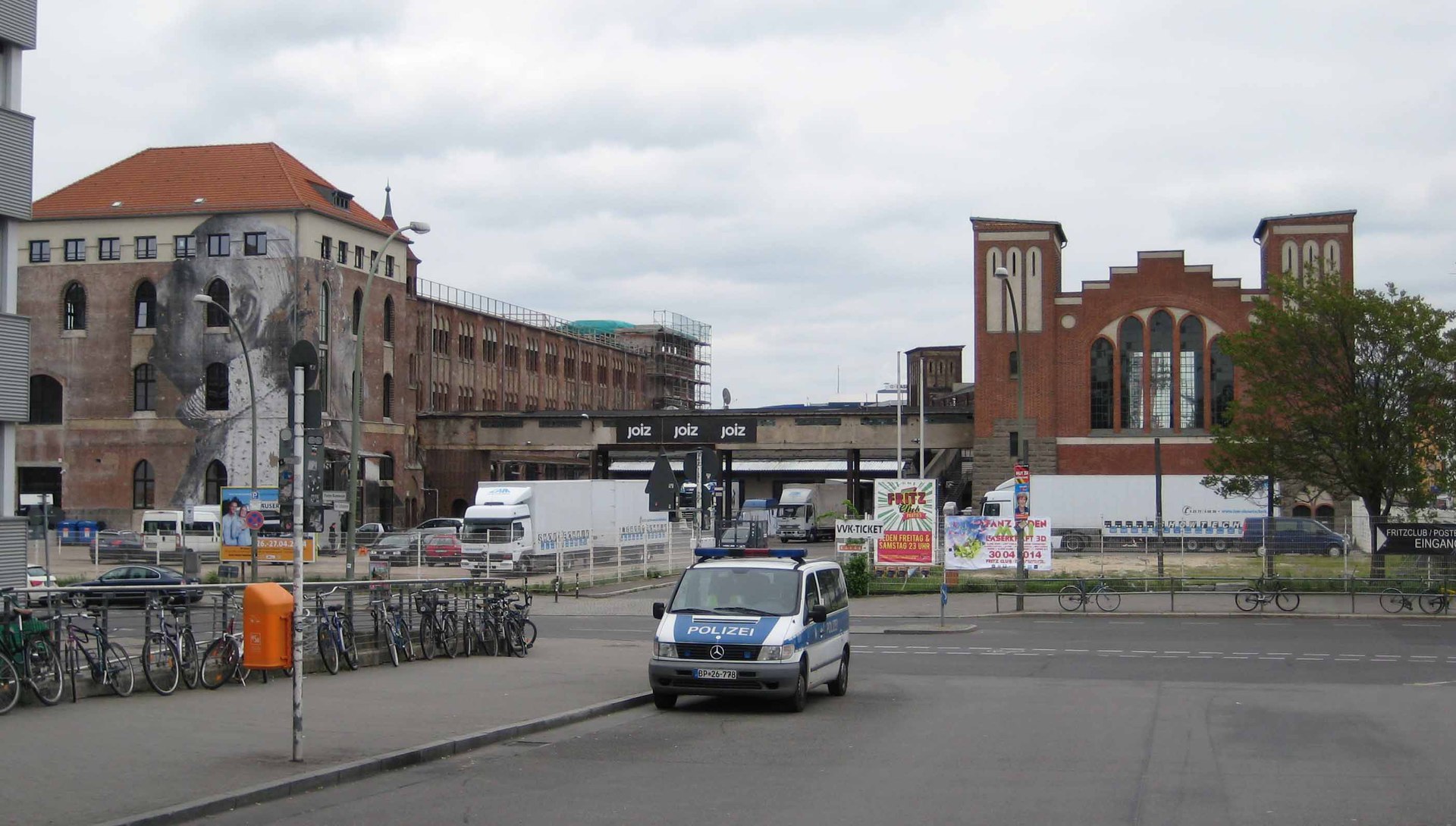Droidcon Berlin 2015: how it was

Among the largest conferences on Android-development in Europe, one can especially note the Droidcon in Berlin and in London. This year the conference is still being planned in the capital of Great Britain, and I have already attended the one that recently took place in Germany. Next is a small report on what was interesting to hear and see at the Droidcon in Berlin.
Actually, the objectives of the trip were:
- to hear about current trends in development is the main goal;
- chat with other developers from the global Android community;
- evaluate the organizational part of the conference in order to use this experience in Redmadrobot’s own events.
City
Undoubtedly, Berlin is one of the most interesting cities in Europe, which you should definitely visit just as a tourist. Nothing like the atmosphere, convenient public transport, great sea street food and bicycles. The city of constant communication is so multicultural that you can talk with people from a dozen countries in one evening, and English can be heard everywhere along with German.

Surprisingly: in spite of the fact that during the war most of Berlin was actually razed to the ground, in 2015 the city lacked interesting architecture - both old and new. Berlin is being actively reconstructed, old buildings are being repaired and adapted to current tasks. Just in one of these places - POSTBAHNHOF - and passed Droidcon.

')
Format
The first Droidcon was held in Berlin in 2008. Since then, the conference has expanded considerably and is currently taking place in almost all European countries, as well as in some countries of other continents. The main part takes 2–3 days plus a day to the hackathon. As a rule, the conference has many famous sponsors, but you still have to pay for the ticket - this time it cost € 199.
This year more than 800 people came to Berlin. Sessions went in parallel on four stages, so I had to choose what to visit. Each day began with a small introductory, then - the presentations themselves. On the ground floor there was something like an exhibition space for different technology companies, even Microsoft was hustling with its Microsoft Truck. However, most of the stands were presented by European companies that either sold their products or were looking for new employees. But there was a lot of free stuff - stickers, sweets, drinks and even Google Cardboard. You could also participate in various lotteries and win small gifts.

Free Wi-Fi worked steadily throughout the territory, which was useful (at least for viewing the conference calendar). Some statistics:
- 1500 devices were connected to the network during the conference;
- 729 - the maximum number of simultaneously-connected devices;
- 80% of devices were connected via a 5 GHz channel;
- Total traffic for the entire conference - 463 GB;
- Devices with the word "android" - 50.6% of the total, "apple" - 32.8% (including MacBook).
Food and Drink
During lunch, everyone was fed vegetarian food (apparently, to cover all requirements at once), all day there was access to coffee and cookies.

Plus there was a coffee break with cupcakes and, as I said, sweets and drinks at the stands of the companies. In general, not hungry.
Registration and Seminars
The first day was organizational - in the evening it was possible to register and at the same time get to the party dedicated to the end of the Berlin Buzzwords Conference . The second day was completely devoted to barcamps and seminars. For a presentation in the BarCamp format, it was enough to make an appointment in advance, and the time slot was allocated to the narrator. In general, there were not too many interesting things, since many people used this format to advertise their products and companies.
In parallel, on the first floor, seminars were held on various topics. Perhaps the most curious was the Getting Started in VR workshop, where the guys from Carbon Five talked about the basics of building applications for virtual glasses and creating simple demo applications for Google Cardboard.

At the end of the first day, all visitors to Droidcon were invited to sit in the C-base hacker space — a very atmospheric geek space, made like a space station.
Sessions

The next two days were devoted to sessions on various topics. Representatives of Google, Intel, Dropbox, Facebook, JetBrains and other companies spoke. There was a lot of interesting, for myself I made a list of the most interesting sessions:
- The Cognitive Abilities of the Human Mind is one of the most useful conference lectures. Interaction Designer Janne Julsen (Janne Jul Jensen), based on gestalt psychology, explained what was behind the design and guidelines and how best to design an application. It is worth looking as designers to supplement knowledge of interface design, and developers for a better understanding of application design.
- Then a new EventBus v3 was introduced. While in beta, but the developers were shown the convenience of new annotations and its speed, comparing with the previous version and the decision of Otto from Square. What Jake Wharton (Jake Wharton) already had a joke on Twitter . But overall, the new version looks promising, so it’s worth upgrading when it exits the beta stage.
- Developing a SDK for Android apps is a small presentation about developing your own SDK. Like ordinary tips like “think twice before you do something”, so are specific ones - using fatarr, demo applications and mock servers for testing, etc. Unfortunately, there is no video of this session, so you can read pdf- option (and clarify something from me, if necessary).
- Flexing the rules of Material Design - it is interesting to listen from the point of view of applying guidelines to your applications. One of the thoughts of the presentation is “Don't be a copycat”, i.e. It is not necessary to copy Material Design one to one. As proof, applications from the list of Material Design Awards were given, in which some details did not look the same as in the guidelines. Nevertheless, these applications have received awards.
- Kotlin - The Swift of Android . If you still did not know about the existence of this language or want to know its advantages better, then this presentation will be useful. Unfortunately, the language is still under development, but JetBrains hope to finish it soon.
- Whats new in android - the presentation took place a week after Google I / O, so it was interesting to listen to Google developer about innovations in the system. What's new?
- Android M - new OS versions.
- The permision system has been reworked (on devices up to the Android M version, everything will work according to the old one, on M devices and above, the work will depend on targetSdkVersion.), New methods for checking them, the RequirePermission annotation.
- More new annotations - FloatRange, CallSuper, CheckResult, Size.
- New power saving mode Doze mode.
- Voice integration in applications.
- Data binding is already available while beta.
- Design Library - new components that make life easier for developers in the world of Material Design.
- Different new plush in Android Studio.
- AutoBackup for applications - you can specify what to save.
Innovations are slowly being shared with the public, so it’s worth following the Android Developers Blog . - Layout traversals on android - what happens after the call to the requestLayout () method? How is layout output optimized in Android? In this presentation, they talk about the key steps that the Android UI framework takes to display your interface on the screen.
- RecyclerView to the rescue is all about RecyclerView. In fact, there are many examples on the Internet, but it was interesting to hear about using the MVVM pattern along with RecyclerView, which to some extent facilitates the display of items in the list.
- Android reactive programming with RxJava - I think this lecture is enough to understand the principle of reactive programming and its use in Android with the help of RxJava.
You can also see:
- Strip-tease of the Android permission system - a lecture from Genymobile, the basics of permission in Android and Linux. Nothing new, but the presentation is good.
- Level up your Android build - everything about setting up gradle and CI. Useful information if you still have not built CI-processes in development.
- An alternative to fragments: Say Hello to Mortar & Flow - using Square solutions instead of fragments. Mortar is an overlay over the Activity life cycle for using the View as a separate part of the application. Flow describes the screens and their status, as well as the navigation between them. Using these two libraries results in a solution that can replace fragments. Interesting, but little documented and still under development.
- Fitness motion recognition with Android Wear - how to use your watch to detect certain movements. Starting with what sensors it is better to use, ending with a motion detection algorithm. A good lecture to deal with sensors in the Android system.
- Let's go functional - the name speaks for itself, the basic things and the current state of functional programming in Android.
Again, I made this list for myself, I advise you to look at the conference schedule , maybe there will be something interesting for you personally.
Communication
Such conferences offer a rare opportunity to interact with the global community of developers, so it was even a bit surprising to see how some walk apart. Excessive embarrassment in such situations is inappropriate, as it becomes an obstacle to obtaining new information. During the conversation, you can clarify the details, ask for implementation or advice. All developers, even if they work in Google or Facebook, are the same people as all of us :)

Conclusion
Speaking about current trends, in my opinion, it is possible first of all to single out reactive and functionally programming, MVVM and everything related to the build and testing process (but this will probably always be relevant). As for last year's Material Design, everything seems to have calmed down, and the talk was more about general concepts in design.

The organization of Droidcon was on top (however, one could hardly expect anything else from the Germans :). Should I go next year? Information and video from the conference appear on the network quickly enough, so you can find out something from home. But the conference first of all is communication with colleagues. Will I go again? If there is such an opportunity, then, of course, yes. The community is like a living organism, and such activities are a way to integrate into it and make it even more cohesive.
PS Some of the photos are mine, some are made by Gregor Fischer, or taken from other sources and are distributed under the cc-by-sa 2.0 license. More photos can be seen in the album .
See also:
We put controllers on a diet: Android
Architectural design of mobile applications
Architectural design of mobile applications: part 2
Source: https://habr.com/ru/post/260967/
All Articles